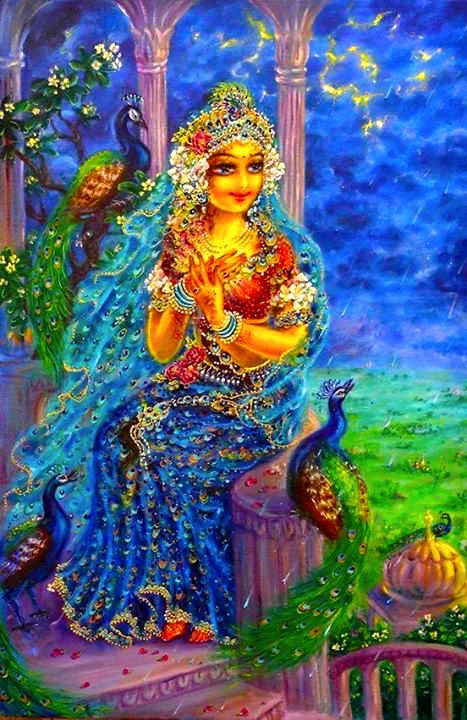Mahanidhi Madan Gopal Das
This series of posts presents the facts (tattva) regarding the identity, moods (gopi-bhava), intimacy and sevas of Srimati Radharani’s beautiful, talented handmaidens known as manjaris, kinkaris, or dasis. Many wonderful lilas are also presented to highlight the manjaris intimate sevas to Srimati Radhika and Her beloved Krishna.
The information here comes from the commentaries of Advaitavamsa Acharya 108 Sri Ananda Gopala Goswami and 108 Sri Ananta Dasa Babaji Maharaja on “Vilapa Kusumanjali” and “Radha Rasa Sudhanidhi” translated by Sri Advaita Dasji.
Lila: Radha Madhava Sing Love Songs
Svamini and Nagara Shyam approach Tulasi Manjari while singing sweet songs on the bank of Radha Kunda. Yugal Kishor enjoy the beauty of the forest bordering Radha Kunda which is full of trees and vines of blooming flowers surrounded by bees thirsty for honey; playful deer and rabbits; and sweetly singing cranes, cuckoos, and parrots. The air is filled with the fragrance of blooming lotus and champaka flowers.
Rai places Her lovely arm on Kanu’s shoulder and embraces Krishna. Srimati’s arm is elegant because of Her maha-bhava, not just because of beauty. Then Swamini puts Her right arm around Shyam’s belly. Shyam hangs His left arm on Radha’s left shoulder, and extends His left hand down to Radha’s breast. How many hundreds of desires arise in Shyam’s heart from Radha’s touch.
In great joy, Swamini taps the rhythm on Shyam’s belly as She sings, “I will tear open My chest and put You in My heart.” Shyam taps the rhythm on Sriji’s bosom. Imagine how sweet are Their voices! Sometimes Radha keeps Her head Shyam’s chest and sings, “O Shyam Bandhu! You are My life! I cannot forget that blessed day I met You! O Kanu! You are My very life! Be kind to Me and give Me the shade of Your lotus feet! I cannot live without You!”
How beautiful is Radhika’s face when She sings this sweet love song! How wonderful are Her gestures! That’s why Tulasi Manjari calls Radha Subhaga-mukhi.
Shyam sings in response, “O Sundari! Remembering Your love again and again, My mind is always agitated. I wander everywhere in Vraja just looking for You! I don’t think of anyone but You! We are two bodies with one soul!” Enchanted by Shyam’s song Radha rewards Shyam with a kiss. There are no sakhis at this time.
Tattva: Tasting Shyam’s Sweetness
Words cannot really express the experience of Shyam’s sweetness. Great saints like Bilvamangala, Jayadeva, Vidyapati, Chandidas, Sri Rupa Goswami, Sri Raghunatha Das Goswami, Kavi Karnapur and Krishnadas Kaviraja personally experienced Sri Krishna’s sweetness and tried to express it in their books.
But ultimately relishing madhura rasa is an individual experience, the fruit successful bhajan. Reading rasika books will give some drops of honey, but the direct experience of Krishna’s madhurya sweet name, form, qualities and lilas will submerge one in an ocean of bliss, anandam buddhi vardhanam!
Tattva: Prayer of a Kundavasi Manjari
Tulasi Manjari tastes boundless bliss seeing Priya-Priyatam and hearing Their love songs of at Radha Kunda. When this vision disappears, however she cries and prays: “Please come once more and look at me! I am all alone here! I will be so happy to see Your blissful pastimes here again! You left me behind here on the bank of the kunda! O Swamini!
“Where shall I go if You reject me? My life is dedicated to Your seva! May the effulgence of Your toenails shine in my heart and soothe it. This is my only desire! How can I like anything else after seeing Your intimate lilas in Radha Kunda?”
By their example the Six Goswamis taught sadhakas how to experience all this. The sweetness of Radha Govinda can be fully relished in the consciousness of a maidservant. By the mercy of Sri Rupa and Sri Raghunath sincere ragamayi sadhakas will someday be blessed with such divine sweet visions, sphurtis!
Radharani’s manjaris ki jai! Jai Jai Sri Radhe!

